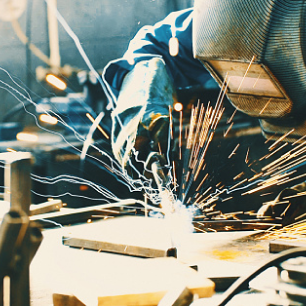Jump to:
Advancing Radiographic Inspection: The Promise of Digital X-Ray Film
The field of nondestructive examination (NDE) has long relied on radiographic film for inspecting welds in pipes, vessels, and other complex structures. Despite significant technological advancements, the industry has been waiting for a more flexible digital alternative that could better replace traditional film while maintaining its unique advantages.
With the rapid development of flexible electronics, particularly in consumer devices such as foldable smartphones and curved monitors, the possibility of a flexible digital gamma/x-ray detector (digital x-ray film [DXF]) seems closer to reality.
DXF represents significant progress in flexible digital gamma and x-ray detector technology. Designed to serve as a digital replacement for radiographic film or computed radiography (CR) plates, DXF combines the versatility of film with the efficiency and accuracy of digital imaging. This innovation could significantly reduce the time and cost associated with radiographic inspection of welds and castings — Fig. 1.
The Evolution of Flexible Electronics
Over the past decade, the flexible semiconductor industry has made remarkable progress. The commercial availability of foldable screens on devices such as Samsung smartphones and the proliferation of curved monitors and televisions highlight how far this technology has come.
These advancements hinge on the same basic technology that underpins the pixelated backplanes used in digital x-ray flat panel detectors (FPDs) — also called digital radiography (DR). By integrating flexible pixelated backplanes with x-ray-sensitive semiconductor inks, we are on the brink of achieving a truly flexible digital equivalent to traditional x-ray film. But is this a practical development or just wishful thinking? To answer this, it is worth examining the current landscape of radiographic inspection technologies.
Traditional Radiographic Film: A Trusted Method
Radiographic film has been a cornerstone of weld inspection since it was first used by Yale University in 1896. Over the years, its performance has improved dramatically in terms of resolution and speed, but the fundamental components have remained relatively unchanged. Modern radiographic film typically consists of multiple layers: a semirigid polyester base layer glued to an emulsion layer of gelatine loaded with silver halide crystals. These crystals, usually silver bromide or chloride, determine the film’s speed and resolution. The emulsion layer is then covered by a protective gelatine layer. In double-layer films, these layers are mirrored on the opposite side of the base layer, doubling the film’s sensitivity to x-rays and gamma rays, thereby reducing exposure times — Fig. 2.
When exposed to radiation, the halide crystals in the film interact with x-ray or gamma-ray photons, releasing negative ions that are then collected by silver molecules. During the development process, these silver molecules form black metallic silver suspended in the gelatine to create the final image. Larger halide crystals capture images more quickly but at the expense of resolution, while smaller crystals offer higher resolution but require longer exposure times.
Despite its limitations, radiographic film is valued for its thinness and flexibility, which allows it to be wrapped around pipes or other complex shapes and held in place during imaging. However, the process is labor-intensive, requiring the film to be loaded into light-proof envelopes in dark rooms and developed manually or automatically. These images must then be digitized for archiving or stored physically — often for decades — in environmentally controlled chambers, which is costly.
Digital X-ray Inspection with FPDs
FPDs originated in the medical industry, which remains the largest market for x-ray imaging technology. FPDs used in NDE are adapted from those designed for medical use. They typically feature square, flat, rigid, and often heavy panels encased in protective housings that add to their weight and cost. While these panels produce high-quality images quickly, their rigidity limits their applicability in weld inspections, particularly for pipes and other complex shapes.
FPDs are relatively thick, making it difficult to position them in tight spaces where they are often needed. Despite these challenges, FPDs offer significant advantages in terms of image quality and speed. The software accompanying these detectors simplifies image analysis, with advancements in artificial intelligence (AI) poised to further enhance this capability.
Most FPDs are indirect conversion x-ray detectors. These detectors use a scintillator material to convert x-rays or gamma rays into visible light, which is then captured by a pixelated backplane, typically made of amorphous silicon (A-Si) or, more recently, indium gallium zinc oxide (IGZO). Each pixel on the backplane contains a photodiode that converts the visible light into an electrical signal, which is processed to generate a digital image. While indirect conversion detectors are well-established in medical imaging, they do have some drawbacks:
1. Conversion losses: The process of converting x-rays to visible light and then to an electrical signal results in some loss of sensitivity.
2. Image blurring: The visible light generated by the scintillator can scatter across multiple pixels, especially in detectors with thick scintillators, leading to blurred images (see Fig. 3).
A Step Toward Digital
CR plates offer a partial solution to the limitations of DR panels, more closely mimicking traditional x-ray film. CR plates are flexible, x-ray-sensitive phosphor plates available in various sizes and resolutions. When exposed to x-rays, the phosphor crystals in the plates release electrons, which are trapped in a higher energy state. This stored charge is later stimulated by a helium-neon laser in a developing station, emitting blue light proportional to the stored image. This light is captured by a photomultiplier tube and converted into an electrical signal, which is then processed into a digital image. After the image is captured, the plate can be cleared by exposure to intense light, making it ready for reuse — Fig. 4.
However, CR plates have their limitations. They are often used in harsh environments where contamination by sand or other materials can damage the plate and affect image quality. Scratches or kinks in the plates can also leave artifacts on the x-ray image, sometimes rendering the plate unusable. Although CR plates are designed for around 1000 exposures, they are often damaged much sooner, and up to 50% of the resolution can be lost during the digitization process.
The Future of Radiographic Inspection
While the market has seen incremental improvements in resolution and software over the past decade, recent innovations have begun to push the boundaries of what is possible in digital radiographic inspection. One such advancement is the development of direct conversion detectors using materials such as cadmium telluride (CdTe) and amorphous selenium (A-Se). These detectors convert x-ray photons directly into electrical signals, eliminating the need for a scintillator and resulting in higher spatial resolution and sensitivity without blurring. However, these detectors have their limitations. CdTe, for example, is a single-crystal structure that is slow to grow, making it expensive and limited in size. These factors, combined with their rigidity, restrict the use of CdTe detectors in NDE. Furthermore, both CdTe and A-Se detectors are typically limited to applications below 200 keV.
More recently, flexible DR detectors have been introduced, which use flexible scintillators on flexible A-Si backplanes. While these offer some flexibility, they remain heavy, thick, and expensive, limiting their potential to replace traditional x-ray film in most applications.
The Promise of Digital X-ray Film
The future of radiographic inspection lies in the continued development of flexible semiconductor technologies. As has been seen with consumer electronics, advancements in flexible displays using IGZO and low-temperature polysilicon (LTPS) thin-film transistor panels have enabled higher resolutions and smaller pixel sizes. These flexible backplanes are now being adapted for use in x-ray detectors. Moreover, the solar photovoltaic industry has spurred the development of flexible organic semiconductor materials as an alternative to Si in solar panels. These materials can create an x-ray-sensitive semiconductor ink when combined with high-attenuation nanoparticles. Coating these inks or polymers onto an A-Si, IGZO, or LTPS pixelated backplane could result in a direct conversion x-ray detector that is both flexible and ultrathin — Fig. 5.
A digital x-ray film made from a flexible pixelated backplane, coated with a direct conversion semiconductor ink, and protected by carbon fiber layers could be less than 1 mm thick and offer the same flexibility as traditional radiographic film. Such a detector would be more resistant to scratches and kinks, making it a viable alternative for weld inspection. The cost of manufacturing these detectors would need to be low enough to make them semidisposable, ensuring that the total cost of ownership remains competitive with traditional film.
Conclusion
While digital x-ray film is not yet commercially available, the technology is rapidly advancing and may soon become a reality. The potential benefits of DXF — including reduced inspection time, lower costs, and improved image quality — make it an attractive prospect for the NDE industry. As flexible semiconductor technology continues to evolve, further innovations are expected that will revolutionize the way radiographic inspection is approached, ultimately leading to more accurate and efficient inspections of critical infrastructure.
NORMAN STAPELBERG (normanstapelberg@silveray.co.uk) is products and marketing director, Silveray, Stockport, UK.


